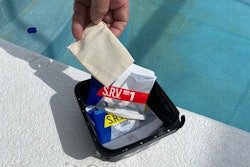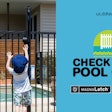The Association of Pool and Spa Professionals is preparing an updated version of the ANSI/APSP-16 standard, a key provision in the Virginia Graeme Baker Pool and Spa Safety Act that deals with the testing, installation and performance of pool and spa drain covers. The changes were prompted by an APSP-16 committee review of the standard to primarily review and update the testing and performance protocols.
“We were talking through the various testing steps, when one test lab said, ‘We do it this way,’ and another said, ‘We do it that way,’” says Carvin DiGiovanni, APSP vice president of technical and standards. “The committee members stopped and said, ‘Wait a minute! You all have to use the same protocols so you get the same results. This is a test standard and the wording needs to be absolutely clear so there is no confusion.”
RELATED: The Future of VGB
For example, some test labs were testing the drain covers for compliance with variable-speed pumps, or different sized testing apparatus, which led to inconsistent and therefore unreliable results.
DiGiovanni stresses that the updated version, which has been approved by ANSI, contains more clarification than new information, and that the changes it mandates are aimed mostly at manufacturers and test labs who will actually be doing the testing. Still, there are some changes to labeling and documentation requirements that pool contractors and operators will need to know about for compliance purposes.
“We don’t expect our installers and industry professionals to be experts on these new testing requirements,” he says. “All they really need to know is that the cover assembly is labeled and installed in compliance with the standard, and that when installed its performance flow rate matches or exceeds the pump rating flow. This aspect is extremely important and should not be taken lightly.
“It’s like a building inspector checking on a compliant pool safety alarm: ‘As long as the alarm is labeled UL-certified to the standard, he is satisfied that it is in compliance and doesn’t have to know any more than that.”
Lessons Learned
Pool professionals who were around when President George W. Bush signed VGB into law in 2008 may wince at the news of impending changes to APSP Standard 16. Back then, Congress gave manufacturers, test labs and workers in the field just one year to design, test and install drain covers that complied with the new law in all the nation’s commercial pools and spas, numbering more than 300,000, according to APSP. There was a surplus of confusion and a shortage of compliant covers, leaving the industry scrambling to bring commercial pools and spas into compliance as the deadline loomed. Some public pools were even forced to shut down until they were brought up to code.
“That was a big problem,” says Steve Barnes, director of science and compliance for AquaStar Pool Products in Ventura, Calif., and chairman of the APSP-16 drain cover standard committee. “We learned a lot from that experience, and the difference this time is it’s simply a manufacturing-date change. So it’ll say, ‘On this date, you have to manufacture drain covers to the new standard.’ Everything they made prior to that will still be legal to sell, but they can’t keep making the old ones.”
RELATED: VGB, ADA, ACA Explained
Once this updated APSP 16 Standard is approved by the Consumer Product Safety Commission as the “successor” drain cover standard, it will become the replacement standard in the law and manufacturers will have 18 months from CPSC approval to comply with the standard. Again, everything already in the stream of commerce will still be compliant and legal to sell and install. Drain covers already in place will not need to be updated.
“That’s really the biggest change in our experience with mandating drain covers,” Barnes says. “It’s not retroactive.”
New Terms
By way of clarification, APSP introduced a new term to describe what’s always been called a “drain cover” in the VGB Act. Problems arose when people interpreted the term “drain cover” too literally and too narrowly, assuming that drain covers stamped with VGB were legal and compliant. It turns out the intent of the law was a little more nuanced than that.
Barnes explains: “Technically, swimming pool ‘drain covers’ are not really covering drains, they’re covering suction outlets. The committee agreed, these devices really should be called ‘suction outlet fitting assemblies,’ or SOFAs.”
Sounds like a distinction without a difference, right? Actually, the language is aimed at spelling out everything the “drain cover” standard encompasses, and not just the cover itself, in order to improve the law’s effectiveness. The drain cover is only one critical part of a system, hence the new term “suction outlet fitting assembly,” which is the new title of standard.
During the APSP-16 review, the committee took a look at suction entrapment incidents since 2008 to see if they could spot any patterns. First, they learned there had been no deaths related to suction entrapment since the VGB law was passed — an undeniable success! On the other hand, there were some non-fatal suction-entrapment incidents, and the majority of them had a troubling factor in common.
“Most of the entrapments took place because the cover was missing,” DiGiovanni explains. “So we concluded it’s not just the drain cover that needs to be compliant, but the fastening device as well. That’s where the committee started looking at this as a system resulting in the new name, ‘suction outlet fitting assembly.’ So if a manufacturer makes a two- or three-part drain assembly, all the parts come together as one and must be tested to the APSP-16 Standard.”
Does this mean pool pros are going to have to stop calling the devices “drain covers”? Not at all.
“It will take time because in this industry it’s always been either ‘main drain, or drain cover.’ We’re trying to break through that,” DiGiovanni says. “Our manufacturers are in on the new language, but if you walked into a retailer and said, ‘I want a suction outlet fitting assembly’ they’d look at you puzzled. But if you say ‘drain cover’ they’ll know exactly what you’re talking about.
“It’s a cultural thing that we’re trying to change and this is the start. Even the people at the CPSC still refer to it as a ‘drain cover’ as opposed to a ‘suction outlet fitting assembly,’ but eventually it will sink in. What has been accomplished is the VGB requires all parts of the SOFA or simply everything that attaches to the pipe, to be compliant. The new APSP-16 Standard is leading the way to make that happen within the act.”
Need To Know
The new terms and critical clarifications will help manufacturers and test labs ensure compliance with the letter and spirit of the VGB law (APSP-16 Standard), and will hopefully reduce suction incidents even further. But what exactly does an installer need to know as the standard moves toward adoption and implementation?
Barnes brings up the rolling manufacturing date, where compliant drain cover assemblies in the pipeline will be legal to sell and install until they’re gone. If they’ve got it at the distributor, and it’s marked “VGB” and not past its expiration, it’s legal. What, then, will the new drain covers (or SOFAs, to be precise) be marked with?
“The big change here is drain cover manufacturers will have to provide documentation in the form of a label or a sticker that comes with the product that describes what the product is (i.e. floor SOFA vs a wall SOFA), gives the technical details and then has a space where the installer indicates the month and year that product gets installed,” Barnes explains. “That has to then be provided to the property owner so that if the pool gets a government inspection or it gets a new owner, there’s a record of when the SOFA (drain cover) was installed so you can replace it before its service life expires.”
RELATED: Beating Pool Drain Entrapment With Proper Plumbing
Another change makes clear that drain covers need to have a flow rating that can handle the flow potential of the pool’s pump. Again, this is not a new idea in the law.
“The way I’d characterize the flow rating and testing parameters and 95 percent of what’s changed in APSP-16 is ‘clarifications.’ It’s really no different from what should be happening now,” Barnes explains. “Unfortunately a lot of people didn’t understand what was written in the law.
“When we looked at those entrapment incidents, we saw mistakes with flow rating, the type of cover relative to the type of pool, fasteners not being used properly, incorrect sump depths leading to hair entanglement. We’re trying to get the manufacturers to provide the industry with better information about the drain assemblies and it’s reflected in the new APSP-16 Standard.”
According to DiGiovanni, improved documentation and installation information will help installers make sure their pools and spas comply.
“It’s one thing to test a drain cover or suction fitting to the standard. That’s fine,” he says. “But when it comes to installation, APSP-16 says you need to follow the manufacturer’s instructions or the approved cover’s performance may be at risk. For example, there’s no mixing and matching of assemblies between different manufacturers. You can’t put one manufacturer’s drain cover on another manufacturer’s fastening assembly. By doing so, you are creating a potential hazard. If you don’t follow the manufacturer’s instructions, the system is out of warranty and the manufacturer is no longer going to be responsible for anything that goes wrong.”
Information Delegation
Supported by CPSC data, DiGiovanni calls the first 10 years of VGB a big success. In addition to reducing suction-entrapments, he says it has helped raise awareness about the importance of layers of protection in preventing drowning and overall pool safety in general.
“The data is telling us the law is working,” DiGiovanni says. “Between industry education and proper installations, VGB and APSP-16 have been very effective. There’s more awareness now indicating that the best safeguard against entrapping swimmers is to constantly inspect to make sure the drain cover is properly in place, that it’s not broken or loose and that it’s not expired.”
And while the industry and the CPSC deserves a pat on the back for its part in the law’s success, spreading the word about the new changes to APSP-16 will make pools and spas even safer, according to DiGiovanni.
“This is big news,” he says, “and the APSP will get the news out not only to the industry professionals but also to the pool owners: Make sure your drain covers are securely installed and have the latest APSP-16 embossed criteria on them. If in doubt, contact your local pool and spa professional.”
For his part, Barnes has been giving presentations on behalf of AquaStar about the APSP-16 Standard updates at trade shows across the country. Other drain cover manufacturers will inform their network of dealers, builders and service technicians, too. Barnes admits it will require a sustained effort.
“Getting this kind of messaging out to penetrate all pockets of the industry is always a challenge, but we’re moving in the right direction regardless” he says. “There’s the CPSC site poolsafely.gov, which will explain all the changes, there’s the outreach that APSP and the industry does. But the focus here has been on installation instructions, the sticker that will come with the cover, getting more instructions and information on the manufacturers’ websites and cutsheets.”
“The biggest impact however will be the fact that the International Swimming Pool and Spa Code already references the APSP-16 Standard, which means that the 21 states and 116 jurisdictions that have adopted the ISPSC now mandate compliance with the APSP-16 Standard. Consequently, it’s the law in all these jurisdictions!”
Timeline
A published copy of the ANSI/APSP/ICC-16 Standard will be sent to the Consumer Product Safety Commission, where commissioners will have 45 days to review it. Barring unexpected delays, they will approve it in May.
“Assuming we can keep to that timeline, the standard will go into effect 18 months after the CPSC approval date,” DiGiovanni says. “Our APSP drain cover manufacturers and all the test labs are on the APSP Standard 16 committee and already know what to expect, so they are tooling up and getting ready. There will be no surprises.”




































